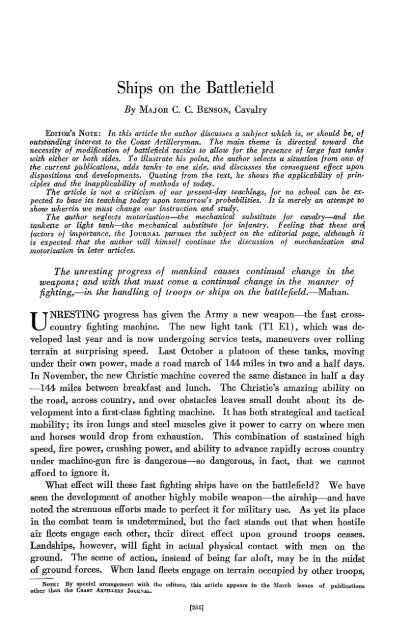THE COAST ARTILLERY JOURNAL - Air Defense Artillery
THE COAST ARTILLERY JOURNAL - Air Defense Artillery
THE COAST ARTILLERY JOURNAL - Air Defense Artillery
Create successful ePaper yourself
Turn your PDF publications into a flip-book with our unique Google optimized e-Paper software.
Ships on the Battletield<br />
By MAJOR C. C. BENSON, Cavalry<br />
EDITOR'S NOTE: In this article the author discusses a subject which is, or should be, of<br />
outstanding interest to the Coast <strong>Artillery</strong>man. The main theme is directed toward the<br />
necessity of modification of battlefield tactics to allow for the presence of large fast tanks<br />
with either or both sides. To illustrate his point, the author selects a situation from one. of<br />
the current publications, adds tanks to one side, and discusses the consequent effect upon<br />
dispositions and developments. Quoting from the text, he shows the applicability of prin.<br />
ciples and the inapplicability of methods of today.<br />
The article is not a criticism ot our present-day teachings, for no school can be expected<br />
to base its teaching today upon tomorrow's probabilities. It is merely an attempt to<br />
show wherein we must change our instruction and study.<br />
The anthor neglects motorization-the mechanical substitute for cavalry-and the<br />
tankette or light tank-the mechanical substitute for infantry. Feeling that these are!<br />
factors of importance, the <strong>JOURNAL</strong> pursues the subject on the editorial page, although it<br />
is expected that the author will himself continue the discussion of mechanization and<br />
motorization in later articles.<br />
The unresting progress of mankind causes continual change in the<br />
weapons; and with that must come a continual change in the manner of<br />
fighting,-in the handling of troops or ships on the battlefield.-Mahan.<br />
UNRESTINGprogress has given the Army a new weapon-the fast crosscountry<br />
fighting machine. The new light tank (T1 E1), which was developed<br />
last year and is now undergoing service tests, maneuvers over rolling<br />
terrain at surprising speed. Last October a platoon of these tanks, moving<br />
under their own power, made a road march of 144 miles in two and a half days.<br />
In November,the new Christie machine coveredthe same distance in half a day<br />
-144 miles between breakfast and lunch. The Christie's amazing ability on<br />
the road, across country, and over obstacles leaves small doubt about its development<br />
into a first-classfighting machine. It has both strategical and tactical<br />
mobility; its iron lungs and steel muscles give it power to carryon where men<br />
and horses would drop from exhaustion. This combination of sustained high<br />
speed, fire power, crushing power, and ability to advance rapidly across country<br />
under machine-gun fire is dangerous--so dangerous, in fact, that we cannot<br />
afford to ignore it.<br />
What effect will these fast fighting ships have on the battlefield? We have<br />
seen the development of another highly mobile weapon-the airship-and have<br />
noted the strenuous efforts made to perfect it for military use. As yet its place<br />
in the combat team is undetermined, but the fact stands out that when hostile<br />
air fleets engage each other, their direct effect upon ground troops ceases.<br />
Landships, however, will fight in actual physical contact with men on the<br />
ground. The scene of action, instead of being far aloft, may be in the midst<br />
of ground forces. When land fleetsengage on terrain occupied by other troops,<br />
NOTE: By special arrangement with the editors, this article appears in the ~Iarch issues of publications<br />
other than the <strong>COAST</strong>AaTILLEIty JOURX.u••<br />
[25+]
















